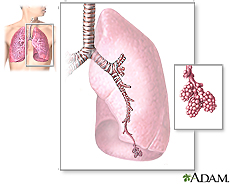 |
 |
 |
Other Health Topics:

-
Related Topics
-
Go Local
- Services and providers for Legionnaires' Disease in the U.S.
-
National Institutes of Health
- The primary NIH organization for research on Legionnaires' Disease is the National Institute of Allergy and Infectious Diseases
Legionnaires' disease is a type of pneumonia caused by bacteria. You usually get it by breathing in mist from water that contains the bacteria. The mist may come from hot tubs, showers or air-conditioning units for large buildings. The bacteria don't spread from person to person.
Symptoms of Legionnaires' disease include fever, chills, a cough and sometimes muscle aches and headaches. Other types of pneumonia have similar symptoms. You will probably need a chest x-ray to diagnose the pneumonia. Lab tests can detect the specific bacteria that cause Legionnaires' disease.
The bacteria are more likely to make you sick if you
- Are older than 65
- Smoke
- Have a lung disease
- Have a weak immune system
Legionnaires' disease is serious and can be life-threatening. However, most people recover with antibiotic treatment.
Centers for Disease Control and Prevention
- Patient Facts: Learn More about Legionnaires' Disease(Centers for Disease Control and Prevention)
| Basics | Learn More | Multimedia & Cool Tools |
|---|---|---|
| Research | Reference Shelf | For You |
|
-
Overviews
- Legionnaires' Disease(Mayo Foundation for Medical Education and Research)
- Legionnaires' Disease(Occupational Safety and Health Administration)
-
Related Issues
- Resuming Safe Operation of Building Water Systems: Risk of Legionnaires' Disease(Centers for Disease Control and Prevention)
-
Pictures & Photographs
-
 Legionellosis (Legionnaires' Disease)(Logical Images)
Legionellosis (Legionnaires' Disease)(Logical Images)
-
-
Clinical Trials
-
ClinicalTrials.gov: Legionnaires' Disease
 (National Institutes of Health)
(National Institutes of Health)
-
ClinicalTrials.gov: Legionnaires' Disease
-
Journal Articles
References and abstracts from MEDLINE/PubMed (National Library of Medicine)
- Article: An outbreak of Legionnaires' disease associated with a circulating bathwater...
- Article: Severe Legionella pneumonia: rapid presumptive clinical diagnosis with Winthrop-University Hospital's...
- Article: NAIP and Ipaf control Legionella pneumophila replication in human cells.
- Legionnaires' Disease -- see more articles
- Medical Encyclopedia Return to top
-
Organizations
- National Center for Zoonotic, Vector-Borne, and Enteric Diseases, Division of Foodborne, Bacterial and Mycotic Diseases(Centers for Disease Control and Prevention)
-
National Institute of Allergy and Infectious Diseases

| Home | Health Topics | Drugs & Supplements | Encyclopedia | Dictionary | News | Directories | Other Resources | |
| Disclaimers | Copyright | Privacy | Accessibility | Quality Guidelines U.S. National Library of Medicine, 8600 Rockville Pike, Bethesda, MD 20894 National Institutes of Health | Department of Health & Human Services |
Date last updated: 10 September 2008 Topic last reviewed: 06 June 2008 |






